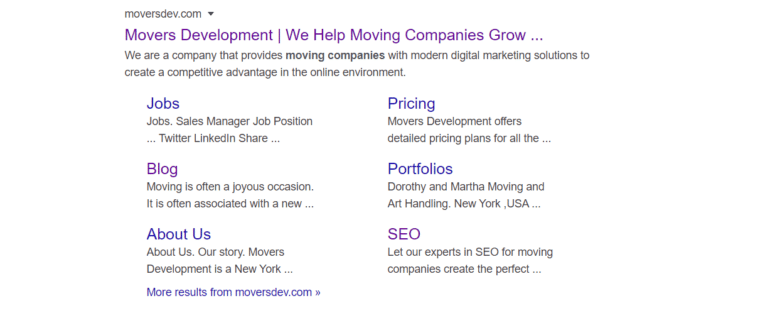Working in a competitive environment is just as good for individuals as it is for businesses. Competition is what pushes us to be better and to step outside of our comfort zone. It is the motivation we need to maintain our qualities while working on creating new ones. And the same applies to the world of Search Engine Optimization (SEO) for moving companies. Creating your own unique strategy and path is important, but analyzing your competitors to do so is fundamental. Today, Movers Development guides you through the process of SEO competitive analysis and how it can grow your business.

8 key steps to SEO competitive analysis and how to apply it
Before we get into applying it, we need to define what it is.
- SEO competitive analysis is an approach where one researches the SEO efforts of their competitors, analyzes them in detail, and then uses them to create or boost their own strategy.
Content, links, advertising channels, keywords that moving companies use, their websites – these are all key factors to take into consideration. And it is all an essential part of the analysis process. Now that we’ve established the basics, time to go through the actual process. So, here is our 8-step process take on SEO Competitive Analysis:
1. Identify your SEO Competitors
Knowing your competition is essential for any business, but so is defining your SEO competitors. And before you ask – they might not always be the same. Just as there are competitors who don’t invest as much in moving company SEO, there are those companies outside your niche that might rank for the same keywords you do.

The sooner you are able to identify your competition in the SEO world, the better equipped you will be to adapt your efforts in the same manner. And learning who those companies are is as simple as typing in the keyword you want your business to rank for and looking at the results on the first couple of pages of search results.
Of course, there are more advanced ways to look into this, given the many keywords research tools that can analyze your competition for you.
2. Evaluate the difficulty of ranking for a keyword
Doing an assessment of your niche and the keywords you wish to rank for is always a good starting point before any serious SEO efforts. So, put aside the on-page SEO modifications and link-building strategies for now. Focus your efforts on evaluating the chances of ranking for certain keywords through the use of SEO competitive analysis.
In theory, every keyword out there is a potential target for any company. However, each industry has keywords that are borderline impossible to rank for. Those keywords usually require a high amount of investments and resources, not to mention the time to rank for them. And those are usually the whirlpools for small moving businesses with no prior experience in search engine optimization. Instead, you need to be realistic when choosing the moving company keywords you wish to hunt for.
How can you use SEO competitive analysis to make the selection?
It’s not as complex as you think. Basically, it once again comes down to looking closely at the competition and their targets. Consider the domain strength of your niche competitors and take each of the elements apart for further analysis:
- Domain authority.
- Domain country and age.
- Search engine indexing.
- Business listings.
- Backlink profile.
- Current rankings on search results
- Traffic volumes.
- Social media profiles.

Once you dig up all the information, you can take a closer look at the weaker and more fallible points. These are your potential advantages when it comes to coming out on top of your competitors for certain keywords. In most cases, the rule of thumb is as follows:
- The higher the authority of a competitor, the stronger their SEO strategy is and the harder it will be to outrank them.
Rather than waste your resources on such companies, you would be smart to focus your efforts on competitors with lower overall scores. Start from the weaker links in the chain and work your way up slowly. After all, competitive SEO analysis is a race where patience is key.
3. Explore other potentially profitable keywords
You can use TF-IDF (term frequency-inverse document frequency) analysis to evaluate and upgrade your existing content with keywords that your competitors tend to use. That will offer you the chance to gain additional target keywords to focus your efforts on, some of which might be low-competition enough for you to find your opening among them.
- By definition, TF-IDF is a measurement of how often a keyword appears on a page (term frequency) multiplied by how often a keyword is expected to appear on page (inverse document frequency).
This particular approach can be applicable to your SEO competitors and the content they have on their websites. It can often offer insight into the synonymous keywords and phrases that might appear in other content on top search engine results but is somehow lacking in your own. You can use this to improve your existing content or to create new pages/posts that will focus on those particular keywords you are missing.
For example, using TF-IDF, we discovered that high-ranking content for the keyword “cardboard moving boxes” almost always contains specific information about different types & sizes of moving boxes, packing supplies, packing techniques, etc.
4. Always include on-page optimization and content in your competitive analysis
You should never underestimate the information that competitive analysis tools such as SEMrush can offer your moving business. There is a gold mine of data hiding behind each SEO competitive analysis – all you need to do is look for it. When it comes to on-page optimization factors and the online content of your competition, you can learn a lot from it just by considering the following:
- The frequency of publishing content;
- Type of content they publish;
- The keywords they target with their content;
- Metadata (title and description)
- Content structure (headlines, title length & tags, use of keywords in titles, etc.)
- Internal linking strategy
- Word count
- Image quality and optimization
- Use of bold/italic, as well as bullet lists, etc.
It is a well-established fact that all these elements are essential for search engine bots that crawl through content. And all of them influence your overall chances of ranking for a particular keyword in some part. So, you need to take a closer look at the on-page SEO efforts of your competitors and adapt your content accordingly. Make it better and more engaging to potential site visitors.

5. Explore the extent of the backlink profile that your competition has
The backlink profile that a company has is both a crucial ranking factor as well as a way to generate more traffic on its website. Therefore, it is only logical to examine the backlink profiles of competitive businesses in your niche. By doing so, you can determine which websites they link from and reach out to those websites and negotiate your chance of earning links leading to your website.
Additionally, the SEO competitive analysis of backlinks can help you generate a larger list of quality websites from sister industries that can serve to boost your online presence. All this can lead to new linking opportunities, which can ultimately result in higher rankings for specific keywords and web pages.
6. Take a closer look at the structure and user experience that other websites offer
User Experience (UX) has been a focus of Google’s for a while now, with each update shifting a larger portion of priorities on engaging your target audience in the best manner possible. Whether we’re talking about faster loading pages, responsive web design for mobile users, improved search results, etc. – the conclusion lies in UX. The truth is that you cannot hope to beat your competitors with a slow and unresponsive website that nobody can navigate through.
Instead, you need to take a closer look at the websites of your competitors and use SEO competitive analysis to gain insight into the web development and web design efforts that makes them stand out. Consider how their websites win out against your own and use that as a guide to upgrading your pages.
Focus your SEO competitive analysis efforts on landing pages
One of the finest ways to learn what makes other companies in your niche stand out is taking a closer look at their landing pages. Once you actually do so, consider the following:
- Click-through ratio;
- Traffic on those pages;
- Heat map for each page;
- PageRank distribution;
- Parent/child pages that they might have;
- Calls to Action (CTAs) and how engaging they are, etc.
7. Explore their approach to social media tactics
Professional digital marketers still discuss the role that social media plays in SEO and the level in which the two are in fact related. However, it is certain that the connection is there, and that social media strategies are healthy for any SEO tactic. By using social listening tools, you can determine just how much your competitors are investing in their campaigns. Additionally, a good social listening tool can help you increase overall traffic by tracking mentions of your website on different social media platforms and off them.
Focus your competitive research on the following social media activities of your competitors:
- Type of social media networks that other companies are using.
- The posting schedule of your SEO competitors when promoting content.
- How they approach communicating with audiences
- The type of social media content with the most engagement.
8. Tracking the paid advertising budget and tactics of your competition
You’ve optimized your website to the fullest and developed strong SEO and social media strategies, but other companies still seem to have the upper hand. That sounds like the time to shift your SEO competitive analysis in the direction of their ads and how much they invest in them. Sometimes, all it will take for your competitors to generate more conversions is for them to outspend you when it comes to online advertising.
A step in the right direction here would be to try and match their budget and bidding efforts when it comes to keywords. However, not all companies might be able to invest that amount of resources. Hence, what you miss out on in terms of budget, you will want to make up for by working on the quality of your paid ads. Look at the ads of other companies and try to outmatch them in terms of quality of content, choice of banner ads, scheduling, etc.
Save time on SEO Competitive Analysis with the help of professionals
Movers Development understands how competitive the moving industry can be. Additionally, we have a rich and diverse combined knowledge and experience when it comes to digital marketing for moving companies. With us to help you, you won’t need to waste time or energy on mastering the efforts of your competitors and outmatch them. Because our team will be here to do this for you.
- Contact us today to schedule a free marketing analysis of your website and learn all about how you can!






